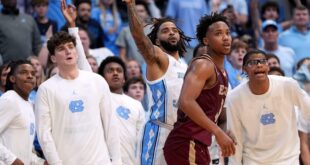NEW YORK — When Shohei Ohtani was a sophomore in high school, his baseball coach at Hanamake Higashi High introduced him to a method of self improvement called the Harada Method.
Named for Takashi Harada, a former physical education teacher in Japan, the method found its way to Hanamake Higashi through Hiroshi Sasaki, the school’s meticulous and venerated baseball coach. It included five stages — goals, purpose, analysis, plan and action — and the way Sasaki saw it, it offered his players a blueprint for their futures.
According to the method, the players at Hanamake Higashi had to write down their goals and a list of strategies to achieve them. The resulting document was a 9-by-9 grid that Harada calls a 64 chart, and when Ohtani sat down to fill his out, he wrote of matters philosophical and practical. He wanted to have a “tenacity for victory” and “a cool head and hot passion.” He wanted to read more books, pick up after himself, gain weight and “get rid of uneasy feelings.”
Ohtani wrote of wanting to throw a baseball 99 mph — or 160 kph, as it’s measured in Japan — and become a top prospect. But another box seemed to encapsulate his mission:
“Have clear goals and purposes.”
Ohtani would eventually leave Hanamake Higashi and its somewhat rural confines in Iwate Prefecture, but he never stopped making goals. He wanted to play in Nippon Professional Baseball as a pitcher and a hitter. So he did.
He wanted to do the same in the major leagues, upending a century of conventional baseball wisdom. So he did.
He won two Most Valuable Player awards for the Los Angeles Angels as perhaps the most singular talent in baseball history — starring as a pitcher and a hitter. He signed a $700 million contract with the Dodgers and deferred $680 million of it for 10 years. And when a second Tommy John surgery left him unable to pitch this season, his first season in Los Angeles, he set a goal to be the first player in history to hit 50 homers and steal 50 bases. He did that, too.
Shohei Ohtani tries out the new hardware! #WorldSeries pic.twitter.com/QqCvz15F4L
— MLB (@MLB) October 31, 2024
The latest goal he achieved, as it happens, came late Wednesday night, in the moments after the Los Angeles Dodgers won the World Series over the New York Yankees with a heart-stopping 7-6 victory in Game 5. In the midst of a euphoric celebration, with Kendrick Lamar blasting and beer pooling into puddles on the floor of the visiting clubhouse at Yankee Stadium, Ohtani ran into Andrew Friedman, the Dodgers president of baseball operations.
When the Dodgers had recruited Ohtani to Los Angeles last winter, team chairman Mark Walter had mentioned the club’s checkered October past. The Dodgers had been the class of the sport for a decade but had just one World Series championship in 2020 to show for it. Walter labeled it “a failure.”
On Wednesday, as one championship became two, Ohtani had a message for Friedman.
“All right,” he said, “nine more, nine more.”
The “nine,” in this case, was World Series championships, which corresponded with the nine seasons that Ohtani has remaining on his Dodgers contract.
“In his first year, he won a championship,” Friedman said. “He’s like, ‘This is easy. We’re just gonna do it again nine more times.’”
One can assume, of course, that Ohtani was joking. Maybe it was the champagne talking. But considering everything else he’s accomplished in his seven seasons in the major leagues, maybe it was just one more goal to chase.
“We were able to get through the regular season, I think, because of the strength of this team, this organization,” Ohtani said in a news conference late Wednesday night. “And the success of the postseason is very similar to how we were able to pull it off during the regular season. Again, the strength of the organization. (I’m) extremely honored to be a part of this.”
On the field, Ohtani’s first World Series had not gone quite to plan. He was just 1-for-8 at the plate before sustaining a partial dislocation of his left shoulder in Game 2. He returned for Game 3 in New York, wearing tape to keep his shoulder in place, but he hit just .105 (2-for-19) with two walks for the series. If Ohtani was more injured than he let on, even Friedman was not sure.

Ohtani struggled at the plate after his injury in Game 2 of the World Series. (Kiyoshi Mio / Imagn Images)
“He was playing with one arm in the postseason,” Dodgers manager Dave Roberts said. “So most guys would probably tap out, but he was going to not be denied at playing and posting and being in the lineup.”
It did little to mute Ohtani’s excitement inside the clubhouse. At 12:53 a.m., he emerged from the center of the party and sprayed Friedman in the face with champagne. Three minutes later, he got Walker Buehler, surprising the starting pitcher who had come on in relief and closed out Game 5. As Ohtani moved about the room, he seemed to tilt the gravity of the celebration, a wave of Japanese reporters following in his wake.
Major League Baseball had granted nearly 180 credentials to media members from Japan, another number that helped measure Ohtani’s impact on baseball and the Dodgers. Nearly 16 million people in Japan tuned in to the Dodgers’ victory in Game 2. It’s possible, of course, that the numbers could only grow.
When Ohtani likely collects his third MVP award this offseason, he will be just the ninth player in history with three MVP awards and a World Series ring — and just the third to have debuted within the last 50 years. The other two recent examples are Albert Pujols and Alex Rodriguez, and the rest of the list is dotted with inner circle Hall of Famers: Stan Musial, Yogi Berra, Mickey Mantle, Mike Schmidt, Roy Campanella and Jimmie Foxx.
If you believe Friedman, Ohtani has the opportunity to pass them all.
“I think there’s a legitimate argument that he’s the greatest player to ever play the game,” Friedman said. “So obviously all this does is help further that.”
The case is statistical: In seven seasons, Ohtani has hit 225 career home runs while posting a career .945 OPS, nearly 57 percent better than league average. Over that same period, he has a 3.01 ERA across 86 starts.
The case is also historical: The World Series has been played for more than a century. Nobody has ever quite broken the sport like Ohtani has.
“What Shohei’s done to our ball club, the Dodger fan base domestically, globally, I just don’t think you can quantify,” Roberts said.
As the celebration raged, club president Stan Kasten did not try to quantify the expanding fan base overseas. Instead he spoke of the enduring Dodgers brand.
“We’re Jackie,” he said. “We’re Sandy. We’re Fernando. And on and on and on.”
Soon enough, he’ll add Shohei to the list.
In one corner stood Mookie Betts, a three-time World Series champion, including twice with the Dodgers. And somewhere was Freddie Freeman, the World Series MVP and two-time champ. But in the middle of the room was Ohtani, spraying champagne onto teammate Yoshinobu Yamamoto. At one point, he saw Kasten. The team president offered three words:
“Good choice, Shohei.”
Ohtani would tell reporters that he felt “honored” to play for a team like the Dodgers. The World Series championship itself, he said, was a “tremendous honor.” And the year playing alongside Betts and Freeman had made him a better player and teammate.
“It really allowed me to elevate my game as well,” Ohtani said. “Not just technically, but also my professionalism.”
He was, at last, a World Series champion. He clutched a bottle of bubbly in his arm. Like his days back at Hanamake Higashi, he had chased a dream and accomplished it. Now it was on to the next one.
Nine more?
A reporter asked Roberts about the promise.
“I don’t want to get to pressure yet,” Roberts said. “I’ve dealt with pressure quite a bit. I’m going to enjoy this one. But once we get to spring training, that’s certainly going to be the goal, yes.”
(Top photo: Mike Lawrence / MLB Photos via Getty Images)
 meganwoolsey Home
meganwoolsey Home



